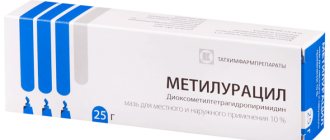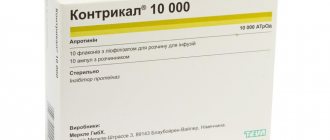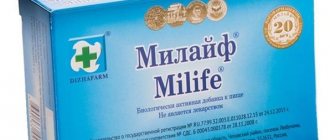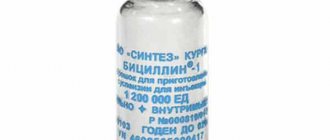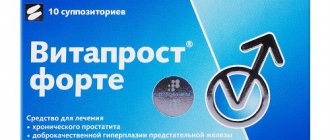Release form and composition
A transparent solution for subcutaneous or intravenous administration, colorless or with a yellowish tint.
Solution 0.2 ml (in single-dose glass syringes, 5 pieces in blisters, 2 blisters in a cardboard pack):
- active substance: dalteparin sodium – 2500 IU (anti-Xa) or 5000 IU (anti-Xa);
- auxiliary components: sodium chloride qs [for a dosage of 2500 IU (anti-Xa)], sodium hydroxide or hydrochloric acid qs, water for injection - up to 0.2 ml.
Solution 0.3 ml (in single-dose glass syringes, 5 pieces in blisters, 2 blisters in a cardboard pack):
- active substance: dalteparin sodium – 7500 IU (anti-Xa);
- auxiliary component: water for injection - up to 0.3 ml.
Solution 0.4 ml (in single-dose glass syringes, 5 pieces in blisters, 1 blister in a cardboard pack):
- active substance: dalteparin sodium – 10,000 IU (anti-Xa);
- auxiliary component: water for injection - up to 0.4 ml.
Solution 0.5 ml (in single-dose glass syringes, 5 pieces in blisters, 1 blister in a cardboard pack):
- active substance: dalteparin sodium – 12,500 IU (anti-Xa);
- auxiliary component: water for injection - up to 0.5 ml.
Solution 0.6 ml (in single-dose glass syringes, 5 pieces in blisters, 1 blister in a cardboard pack):
- active substance: dalteparin sodium – 15,000 IU (anti-Xa);
- auxiliary component: water for injection - up to 0.6 ml.
Solution 0.72 ml (in single-dose glass syringes, 5 pieces in blisters, 1 blister in a cardboard pack):
- active substance: dalteparin sodium – 18,000 IU (anti-Xa);
- auxiliary component: water for injection - up to 0.72 ml.
Solution 1 ml (in ampoules, 10 ampoules in a cardboard box):
- active substance: dalteparin sodium – 10,000 IU (anti-Xa);
- auxiliary components: sodium chloride, sodium hydroxide or hydrochloric acid qs, water d/i - up to 1 ml.
Analogs
Level 4 ATC code matches:
Angioflux
Hemapaxan
Wessel Due F
Fraxiparine
Clexane
Vesel Due F, Athenativ, Flenox, Heparin, Gizende, Clexane, Flenox, Novoparin, Fraxiparin, Tsibor, Enoxaparin.
Indications for use
- pulmonary embolism, acute deep vein thrombosis;
- myocardial infarction without ST segment elevation on ECG or unstable angina;
- long-term treatment (up to 6 months) in patients with malignant neoplasms - to prevent recurrence of venous thromboembolic complications.
In addition, Fragmin is used:
- during surgical interventions - to prevent thrombosis;
- in case of forced limited mobility of patients in conditions requiring bed rest, or in the case of an acute phase of a therapeutic disease - for the prevention of thromboembolic complications;
- for chronic or acute renal failure - to prevent blood clotting during hemofiltration or hemodialysis in the extracorporeal circulation system.
Contraindications
Absolute:
- increased sensitivity to the components of the drug, as well as to heparin and/or any low molecular weight heparins;
- heparin-induced immune thrombocytopenia type II (established, history, or suspected);
- clinically significant bleeding, for example, intracranial hemorrhage or bleeding from the gastrointestinal tract in peptic ulcers of the stomach and duodenum;
- pronounced disturbances in the blood clotting system;
- infective endocarditis, acute or subacute;
- recent injuries and surgical interventions on the organs of hearing, vision and central nervous system.
When treating with therapeutic doses of Fragmin, you should not use regional and/or local anesthesia for planned operations.
Relative:
- impaired platelet function, thrombocytopenia, severe renal or hepatic failure, hypertensive or diabetic retinopathy, uncontrolled arterial hypertension, the postpartum period in women, as well as other factors that increase the risk of bleeding;
- early postoperative period (if it is necessary to use high doses of the drug, great care should be taken);
- children's age (the effectiveness and safety of taking the drug have not been established; in children, during therapy with Fragmin, constant monitoring of anti-Xa levels is required).
Directions for use and dosage
Fragmin should not be administered intramuscularly!
Pulmonary embolism and deep vein thrombosis
Subcutaneous administration of the drug 1–2 times a day is recommended. Therapy with indirect anticoagulants (vitamin K antagonists) can be started immediately. Co-administration should continue until the prothrombin index reaches a therapeutic value (usually at least 5 days). For outpatient treatment, the same doses of the drug that are recommended for inpatient treatment are allowed.
With a single administration of the drug per day, the dose is 200 IU/kg of body weight, but not more than 18,000 IU. When administered 2 times a day, the recommended single dose of the drug is 100 IU/kg body weight. It is not necessary to monitor the anticoagulant activity of the drug, except when Fragmin is used in certain groups of patients (see section “Special instructions”). The recommended maximum concentration of the drug in blood plasma is 0.5–1 IU anti-Xa/ml.
Myocardial infarction without ST segment elevation on ECG or unstable angina
Subcutaneous administration of the drug is recommended every 12 hours at 120 IU/kg of patient weight. The maximum dose is 10,000 IU every 12 hours. In the absence of contraindications, therapy with acetylsalicylic acid is carried out together with Fragmin at a dose of 75 to 325 mg/day. Therapy should continue until the patient's condition stabilizes or longer (at the doctor's discretion, but usually at least 6 days in normal cases). Next, it is recommended to begin long-term therapy with Fragmin at a constant dose until revascularization (coronary artery bypass grafting or percutaneous interventions). Therapy should not last more than 45 days. It is not necessary to monitor the anticoagulant activity of the drug, except when Fragmin is used in certain groups of patients (see section “Special instructions”). The recommended maximum concentration of the drug in blood plasma is 0.5–1 IU anti-Xa/ml.
The dose of Fragmin is selected individually depending on the gender and body weight of the patient.
For women weighing up to 80 kg and men weighing up to 70 kg, a dose of 5000 IU subcutaneously every 12 hours is recommended.
For women weighing over 80 kg and men weighing over 70 kg, a dose of 7500 IU subcutaneously every 12 hours is recommended.
Long-term treatment (up to 6 months) in patients with malignant neoplasms to prevent recurrence of venous thromboembolic complications
1 month – 200 IU/kg body weight subcutaneously once a day. A single dose is not higher than 18,000 IU.
2–6 months – 150 IU/kg body weight subcutaneously 1 time per day, using syringes with a fixed dose, based on the patient’s weight:
- less than 56 kg – 7500 IU;
- 57–68 kg – 10,000 IU;
- 69–82 kg – 12,500 IU;
- 83–98 kg – 15,000 IU;
- more than 99 kg – 18,000 IU.
If thrombocytopenia with a platelet count of less than 50,000/µl occurs during chemotherapy, you should stop taking Fragmin until the platelet concentration increases above 50,000/µl. When the platelet concentration is from 50,000/μl to 100,000/μl, the dose of the drug should be reduced by 17–33% of the initial dose, depending on the patient’s weight. For patient weight:
- less than 56 kg - the dose of the drug should be reduced by 33% (5000 IU instead of 7500 IU);
- 57–68 kg – the dose of the drug should be reduced by 25% (7500 IU instead of 10,000 IU);
- 69–82 kg – the dose of the drug should be reduced by 20% (10,000 IU instead of 12,500 IU);
- 83–98 kg – the dose of the drug should be reduced by 17% (12,500 IU instead of 15,000 IU);
- more than 99 kg - the dose of the drug should be reduced by 17% (15,000 IU instead of 18,000 IU).
After restoration of platelet concentration above 100,000/μl, the drug is recommended to be used in full dose.
In renal failure with serum creatinine concentrations 3 times the upper limit of normal, the Fragmin dose is adjusted so that the therapeutic anti-Xa level, measured within 4-6 hours after Fragmin administration, is 1 IU/ml ( from 0.5 to 1.5 IU/ml). If anti-Xa levels are above or below the therapeutic range, the dose of Fragmin should be reduced or increased accordingly, and the anti-Xa measurement should be repeated after three to four new doses. Dose adjustments are made until the therapeutic level of anti-Xa is achieved.
Prevention of blood clotting during hemofiltration or hemodialysis in the extracorporeal circulation system
- chronic renal failure, as well as patients without the risk of bleeding - dose adjustment is minor, special monitoring of anti-Xa levels is not required. When using recommended doses during hemodialysis, plasma levels are usually 0.5–1 IU anti-Xa/ml;
- hemodialysis and hemofiltration lasting no more than 4 hours - intravenously in a stream of 30-40 IU/kg of body weight, then - intravenously in a drip of 10-15 IU/kg/hour, or once intravenously in a stream at a dose of 5000 IU;
- hemodialysis and hemofiltration lasting more than 4 hours - intravenously in a stream of 30-40 IU/kg of weight, then - intravenously in a drip of 10-15 IU/kg/hour;
- acute liver failure, as well as patients at risk of bleeding - intravenously in a stream of 5-10 IU/kg of weight, then intravenously in a drip of 4-5 IU/kg/hour. In acute renal failure, Fragmin is characterized by a lower therapeutic index, and therefore such patients require regular monitoring of anti-Xa levels. A maximum level of 0.2–0.4 anti-Xa/ml is recommended.
Prevention of thrombosis during surgical interventions
To prevent blood clots during surgical interventions, the drug is administered subcutaneously. As a rule, there is no need to monitor anticoagulant activity. Maximum plasma concentrations when taken in therapeutic doses are 0.1–0.4 anti-Xa.
If there is a risk of developing thromboembolic complications, 2500 IU is administered subcutaneously 2 hours before surgery. After surgery, the drug is administered every morning for the entire time the patient is on bed rest, at a dose of 2500 IU/day.
If there are additional risk factors for the development of thromboembolic complications (for example, a malignant tumor), the drug is administered throughout the entire time the patient is on bed rest (about 5–7 days):
- if prophylaxis is started the day before surgery, 5000 IU is administered subcutaneously on the eve of surgery, in the evening, then 5000 IU subcutaneously every evening;
- if prophylaxis is started on the day of surgery, 2500 IU is administered subcutaneously no earlier than 4 hours after the end of the operation. It is recommended to administer the drug 2 hours before and 8–12 hours after surgery. The morning after the operation and every morning thereafter, 5000 IU is administered subcutaneously.
For orthopedic operations, Fragmin should be used for up to 5 weeks after surgery, choosing the optimal dosage regimen:
- if prophylaxis is started the day before surgery, 5000 IU is administered subcutaneously on the eve of surgery, in the evening, then 5000 IU subcutaneously every evening;
- if prophylaxis is started on the day of surgery - 2500 IU subcutaneously 2 hours before and 8–12 hours after surgery, but not earlier than 4 hours after the end of surgery. Starting the morning after surgery, 5000 IU is administered subcutaneously every morning;
- if prophylaxis is started after surgery - 2500 IU subcutaneously 4–8 hours after surgery, but not earlier than 4 hours after the end of surgery. Starting from the next day after surgery, 5000 IU per day is administered subcutaneously.
To prevent thromboembolic complications in patients with forced limited mobility in the case of the acute phase of a therapeutic disease or in conditions requiring bed rest, the drug is administered subcutaneously at 5000 IU once a day for 12–14 days (if mobility restrictions persist, the course is extended). Monitoring of anticoagulant activity is generally not necessary.
Use of Fragmin in children
The effectiveness and safety of the drug in children have not been established, and there is no data on the recommended dosage regimen.
Monitoring anti-Xa activity in children
The level of anti-Xa activity when measured 4 hours after administration of the daily dose of the drug should be maintained (in general cases) within the range of 0.5–1 IU/ml. In the prophylactic regimen, the level of anti-Xa activity in general cases should be 0.2–0.4 IU/ml. In cases of impaired renal function or its physiological changes (for example, in infants), careful monitoring of anti-Xa activity is required.
Pharmacological properties of the drug Fragmin
Pharmacodynamics. The antithrombotic effect of dalteparin is associated with its ability to enhance the inhibition of factor Xa and thrombin. In general, dalteparin enhances the inhibition of factor Xa rather than prolonging the time of thrombus formation in the blood plasma. Dalteparin has almost no effect on the primary link of hemostasis since its effect on the function and adhesive properties of platelets is insignificant compared to heparin. Pharmacokinetics. Bioavailability, measured by antifactor Xa activity, was 87±6% in healthy patients. Increasing the drug dose from 2500 to 10,000 IU caused a proportional increase in the AUC for antifactor Xa by almost 1/3. The volume of distribution of anti-factor Xa activity of dalteparin was 40–60 ml/kg. After intravenous administration of 40 and 60 IU/kg, the mean terminal half-life was 2.1 ± 0.3 and 2.3 ± 0.4 hours, respectively. After subcutaneous administration, a significant increase in the terminal half-life (3–5 hours) is observed, which may be due to slower absorption. Dalteparin is primarily excreted by the kidneys, but the biological activity of the fragments of the molecule that are excreted by the kidneys has not been well studied. ≤5% anti-Xa activity is detected in urine. In healthy volunteers, after a single intravenous bolus administration of 30 and 120 antifactor Xa IU/kg, the average plasma clearance of antifactor Xa activity was 24.6±5.4 and 15.6±0.3 hours. Hemodialysis. In patients with chronic renal failure who require hemodialysis, the average half-life of anti-factor Xa activity after a single intravenous dose of 5000 IU dalteparin was 5.7 ± 2.0 hours, which significantly exceeds the values obtained in healthy volunteers, since these patients may experience greater accumulation of the drug. Regardless of the route of administration, dose or duration of treatment, no data were obtained that indicated the organotoxicity of the drug. Also, no mutagenic effect was noted. Animal studies have not revealed embryotoxic, fetotoxic or teratogenic effects or adverse effects on fertility, copulation or peri- and postnatal development.
Side effects
Side effects occurred in approximately 3% of cases of taking Fragmin in prophylactic doses.
- lymphatic system, blood: mild thrombocytopenia (type I, usually reversible during treatment), immune thrombocytopenia provoked by the administration of heparin (type II, with or without thrombotic complications);
- immune system: hypersensitivity reactions, anaphylactic reactions;
- nervous system: in some cases, intracranial hemorrhages were observed (some of them were fatal);
- vascular system: bleeding;
- gastrointestinal tract: there are reports of bleeding into the retroperitoneal space (some of which were fatal);
- liver and biliary tract: temporary increase in transaminase levels;
- skin and subcutaneous tissues: temporary alopecia, skin necrosis, rash;
- local reactions: pain and subcutaneous hematoma at the injection site;
- injuries and complications of manipulation: spinal or epidural hematoma.
Side effects in adults and children are the same; their frequency, types and severity do not differ. There is no data on the safety of long-term use of Fragmin in children.
Overdose
hemorrhagic complications , bleeding in the gastrointestinal tract , on the skin, urethra and genitals may develop
Bleeding is accompanied by a decrease in blood pressure hematocrine levels , cold sweat, weakness, and pain.
The drug is stopped to assess bleeding. of protamine sulfate (1 mg per 100 IU Fragmin) is indicated
special instructions
Fragmin should not be administered intramuscularly!
Patients receiving or planning anticoagulant therapy, having a lumbar puncture or undergoing neuraxial anesthesia (epidural/spinal anesthesia) are at increased risk of developing an epidural or spinal hematoma, which may cause long-term or permanent paralysis. This risk increases with the simultaneous use of drugs that affect hemostasis, the use of indwelling epidural catheters for the administration of analgesics, as well as with injuries and repeated epidural or lumbar punctures. In such cases, the patient needs constant monitoring to quickly detect pathological neurological symptoms. If they are detected and neurological pathology is established, emergency decompression of the spinal cord is indicated.
The interval between the last dose of Fragmin and the installation or removal of a spinal or epidural catheter should be at least 10–12 hours. In patients taking large doses of the drug (100–120 IU/kg every 12 hours or 200 IU/kg once daily), this interval should be increased to at least 24 hours. The patient's condition should be periodically and particularly carefully monitored to identify any symptoms or signs of neurological disorders, such as bladder or bowel dysfunction, numbness or weakness in the legs.
There are no clinical data on the use of Fragmin in patients with pulmonary embolism, with concomitant pathologies such as arterial hypotension or shock, circulatory disorders.
The patient's platelet count should be monitored before starting treatment with Fragmin, as well as regularly throughout the entire period of therapy. Patients in whom treatment with Fragmin causes rapid development of thrombocytopenia or thrombocytopenia with a platelet count of less than 100,000/μl require special attention. In these cases, an in vitro test for antiplatelet antibodies in the presence of heparin or low molecular weight heparins is recommended. If the result of this in vitro test is positive or questionable, treatment with Fragmin should be discontinued. This should also be done in cases where it is not possible to conduct a test.
Fragmin only leads to a temporary prolongation of activated partial thromboplastin time (aPTT) and thrombin time. In this regard, you should not increase the dose of the drug in order to prolong the aPTT, as this can cause an overdose and the development of bleeding. Prolongation of APTT should be considered only as a sign of Fragmin overdose.
There is usually no need to monitor the anticoagulant activity of Fragmin, but it may be necessary for certain groups of patients: children, patients with obesity or low body weight, pregnant women, as well as patients with an increased risk of bleeding or recurrent thromboembolism, patients with renal failure.
When taking Fragmin, like other anticoagulants, there is a risk of systemic bleeding. Caution should be exercised when prescribing high-dose Fragmin therapy to patients after surgery. When treating with Fragmin in such patients, constant monitoring of the possible development of bleeding is required through constant periodic examination of the patient, analysis of wound discharge and constant determination of hemoglobin levels and anti-Xa activity.
It is recommended to take blood samples to analyze the activity of Fragmin when the maximum concentration of the drug in the blood plasma is reached, 3–4 hours after subcutaneous injection.
Low molecular weight heparins, and Fragmin in particular, can reduce adrenal secretion of aldosterone and lead to hyperkalemia, particularly in patients with metabolic acidosis, type II diabetes mellitus, elevated blood potassium concentrations, chronic renal failure, or using potassium-sparing drugs. It is recommended to monitor blood potassium in patients at risk.
The units of action of Fragmin and other low molecular weight heparins, unfractionated heparin and synthetic polysaccharides are not equivalent, and therefore, if it is necessary to replace one drug with another, dose adjustment is required.
Long-term heparin therapy is associated with a risk of osteoporosis. When using Fragmin, a similar effect was not observed, despite this, the risk of developing osteoporosis cannot be completely excluded.
In chronic or severe acute renal failure with creatinine clearance less than 30 ml/min, administration of Fragmin at a prophylactic dose of 5000 IU once a day does not cause excessive anticoagulation due to the lack of bioaccumulation and, as a result, does not increase the risk of bleeding.
It is impossible to assess the safety and effectiveness of using Fragmin for the prevention of thrombosis of artificial heart valves, and therefore the use of Fragmin for this purpose is not recommended.
In case of severe liver dysfunction, it is necessary to reduce the dose of the drug and regularly monitor anti-Xa activity.
In patients requiring hemodialysis, a slight dose adjustment of Fragmin is required, and monitoring of anti-Xa activity is recommended.
There is no need to discontinue Fragmin in patients with ST-segment elevation myocardial infarction and if there are indications for thrombolytic therapy.
Elderly patients, especially those over 80 years of age, have an increased risk of bleeding when using Fragmin in therapeutic doses, which requires careful monitoring of the condition of such patients.
Use during pregnancy and lactation
Studies have been conducted on the safety of using Fragmin in pregnant women. According to the results of these studies, Fragmin has a satisfactory level of safety. Tagged:
- no effect on the number of premature births and spontaneous abortions;
- registration of a single case of osteoporosis;
- no cases of heparin-induced thrombocytopenia;
- a small frequency of clinically significant bleeding, mainly observed in the postpartum period;
- no effect on the level of congenital anomalies.
However, due to the existing possibility of adverse effects, Fragmin during pregnancy should be used only as indicated, in the case where the potential benefit to the mother outweighs the possible risk to the fetus.
Absorption of the drug from mother's milk is low. The clinical impact of the slight anticoagulant activity on the absorption of low molecular weight heparin from mother's milk in the newborn is unknown. Women during lactation should take Fragmin with caution.
Drug interactions
Drugs that affect hemostasis, such as non-steroidal anti-inflammatory drugs, thrombolytic agents (streptokinase, urokinase, alteplase), indirect anticoagulants, vitamin K antagonists, dextran, platelet function inhibitors, can lead to an increase in the anticoagulant effect of Fragmin, increasing the risk of bleeding.
In patients with renal failure, when taking Fragmin simultaneously with non-steroidal anti-inflammatory drugs (NSAIDs), special caution is required, since in therapeutic doses NSAIDs reduce the production of vasodilating prostaglandins, and therefore reduce renal blood flow and excretion.
Fragmin is compatible with sodium chloride solution 0.9% for intravenous administration and dextrose solution (50 mg/ml) for intravenous administration.
Pharmacology
The drug Fragmin is a direct anticoagulant, the properties of which are based on the effect of the active element - dalteparin sodium on the functioning of the blood coagulation-anticoagulation system. The active substance is obtained by isolating low molecular weight fractions of heparin from the mucous layers of the pig small intestine using nitrous acid. The method of ion exchange chromatography is used for purification.
The pronounced antithrombotic activity of the drug Fragmin is achieved by inhibiting thrombin with factor Xa through the binding of antithrombin. A distinctive feature of the drug’s sulfated polysaccharide low-molecular-weight chains from heparin is the absence of an effect on platelet adhesion and coagulation rate, which indicates non-inhibition of primary hemostasis.
After administration, the bioavailability of active dalteparin sodium reaches 89%, and the used dosage of the drug does not affect pharmacokinetics.
When administered subcutaneously, the half-life of Fragmin is 200-300 minutes, and when administered intravenously, it is 120 minutes. In patients with kidney pathologies, the half-life will be longer. Dalteparin sodium is excreted by the kidneys.
Important! For anticoagulant therapy of infants under 3 months, it is necessary to increase the dosage of Fragmin by 1 kg of weight.
